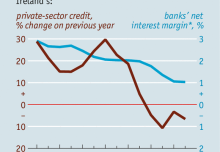BEHIND the smoked glass of a nondescript building in central Paris young people in open-necked shirts interact with Twitter and other social-media networks. This has the feel of a start-up, but in fact it is an outpost of BNP Paribas, one of France’s biggest banks. Hello Bank!, with its catchy name and irritating punctuation, represents one of the most voguish trends in banking. It is trying to entice customers to abandon expensive bank branches and do most if not all of their banking on their mobile phones and tablets.Hello is far from alone in trying to wean customers from bank branches. Newly minted online banks include Simple and Moven in America, Holvi in Finland and Rocketbank in Russia. All this may seem wearily familiar. Around the time of the internet bubble in 2000, new online banks such as Wingspan in America and Egg in Britain launched with a promise to reinvent banking. Most of them soon closed or were sold, defeated by clunky technology and the conservatism of customers.A second wave of digital banks took off in the mid-2000s, with more modest ambitions. Instead of seeking to entice customers away from their existing banks, they merely tried to poach a share of their savings. Firms such as ING Direct and Icesave attracted deposits by offering little more than mouthwatering interest rates. But the savings they achieved by eschewing bricks and mortar were not…


